Sally Bacon discusses the purpose of education and the role of the arts over the past 40 years
We published a think piece, The Arts in Schools: a new conversation on the value of the arts in and beyond schools, in May 2022, reflecting on the 1982 Gulbenkian report on this topic, and developments in arts education since. Between June and September 2022 we convened a series of roundtables on Zoom with school leaders, teachers, arts education practitioners, young people, academics and policy makers on the themes in the original report. What follows are personal reflections on discussions at the roundtable chaired by Mick Water on the purpose of education and the role of the arts. A fuller response to what we heard across all the roundtables and responses to our think piece will be published in a new Arts in Schools report in early 2023.
‘We are now faced with central questions about the purposes of schooling, the balance of the curriculum, and about the whole character of education.’
The Arts in Schools, The Gulbenkian Foundation, 1982
What is schooling for? In the 1970s, when a call for educational accountability was kickstarted by James Callaghan, this new imperative sat alongside questions about the purpose of education and the need to prepare children for employment and a role in wider society. In 1982, The Arts in Schools was clear that a general curriculum policy would be needed to provide a framework of principles for expressive arts provision which related them to the purposes of the whole school curriculum.
We reflected in our think piece that the purpose of education in England has thinned over time in policy terms; that it is now only made visible in the aims of the 2013 National Curriculum and the linked 2019 Ofsted framework; and that there is actually little clarity about purposes, aims and values. In the absence of any national discussion or debate about purpose in recent years, educators have defaulted to responding to a series of accountability measures and Ofsted inspection frameworks, but are these really meaningful or appropriate measures of success? Anything that doesn’t directly respond to these measures has been marginalised.
The over-riding finding across all of our roundtables was that these relentless accountability pressures, and the ways in which these have limited school leader and teacher agency, have served to displace time, energy and legitimacy for the arts in schools; losing sight of the aims of schooling has meant that the particular contribution of the arts has not been valued or seen as relevant. Existing within a purpose vacuum over the last decade, allied with increased government accountability imperatives, the arts within the schooling system seem to have become a proverbial boiling frog.

A considered and collective understanding of the purposes of education should be the basic scaffolding for the system and it does not currently exist in England. When we are clear about the ‘why’ we can get to a consideration of what the arts contribute to those purposes, and their role can be activated and valued. We have written in previous blogs about how we must learn from Scotland and Wales, where purposes have been carefully considered and clearly defined, and have been aligned with structured curriculum areas.
Given the lack of clarity on purposes, our roundtable discussions widened out to reflect on what education is for. Thinking coalesced around active citizenship for democracy and society; empathy and respect; agency and self-efficacy; preparation for the world of work; preparation for a meaningful life; learning from the past and the present; environmental understanding and responsibility; navigating social media and critical media literacy; encouraging creativity; and building a love of learning. Young people should be enabled to respond in informed, humane, imaginative, and values-based ways to the enormous ecological, geo-political, economic, technological and societal challenges they are facing.
The arts have a clear and active role to play across these purposes given their evidenced role in developing critical thinking, a sense of identity, self-belief, agency, confidence, oracy, empathy, compassion, self-expression, independence, collaboration, responsibility, resilience and creative freedom. A huge shift since 1982 has been in the number of children struggling with their mental health and wellbeing, and it is well evidenced that the arts can provide a crucial outlet and support in this context.[1] Children can be empowered by their arts practice: it can enable them to collaborate and to flourish as individuals in their schools, communities and the wider world.
Some key points emerged in our roundtable relating to the principles, practice and provision of the arts in schools. There was agreement that children’s and young people’s involvement with the arts should be embedded and sustained. Purely ‘one off’ experiences act as tasters, and are valuable in themselves, but are more easily abandoned when circumstances change, and funding is tight. We need to prioritise the importance of ongoing, consistent arts education for all children in our schools.
One of the questions we posed when we launched this project was what has been lost or gained over the 40 years since The Arts in Schools was first published? We have seen striking consensus around the value of the 2004 Every Child Matters policy framework, collective agreement around the value of its five goals (which included health) – and significant regret at its loss.[2] It is rare in our view to find such clear support for previous government policy, and there was a will to revisit its ambition and values, and in particular its holistic approach to the lives of children.
Through our consultation we have seen how the arts (and sport) are the subject areas that connect schools into their communities in positive ways: community relationships with and across schools and MATs can be enabled through the arts, showcasing achievements, and engaging parents. The arts can bring together and sustain communities. Place-based partnerships with cultural organisations and artists are vital in providing external expertise, varied experiences, and evidence that arts learning is valued. This community role is wrapped up in the question of the purpose of schooling: do we want schools to be separate silos, teaching subjects remote from real life, or connected community hubs which acknowledge their wider neighbourhood role and their active role in educating for citizenship?
Young people need a broad and balanced curriculum in which the arts are valued. And when we talk about the arts, we need to acknowledge that we are not working with a fixed body of cultural knowledge, but that the arts – and what within the arts is relevant to young people’s lives and lived experience – change and evolve. Acknowledging this is part of what we need to consider if we can redefine the purposes of schooling, and reflect upon how we teach the Expressive Arts as a curriculum area which contributes to these purposes.
Forty years on from The Arts in Schools, it is clear that education in England has lost its way, and failed to embrace wider societal shifts. It has been damaged by an accountability system which fails to address young people’s needs, and which is constructed around a hierarchy of subjects which downgrades the arts. The original report endorsed the idea of accountability but stressed the need for appropriate measures for arts subjects – so if we have now defaulted to what can be measured by exams and Ofsted then of course arts subjects, and those who stand to benefit from them, will suffer. The education system will continue to risk damaging the educational interests it ostensibly seeks to serve until we begin to meaningfully interrogate the purposes of schooling, and to develop a new ambitious vision for education. In the meantime pupils will continue to inhabit an imperfectly built house with no solid foundations.
[1] Arts-Health-and-Wellbeing-Briefing.pdf
[2] Every Child Matters, introduced following the death of Victoria Climbie in 2000, introduced five key outcomes that professionals working with children and young people should strive to achieve. The five outcomes identified were: staying safe, being healthy, enjoying and achieving, achieving economic well-being, and making a positive contribution.




